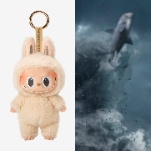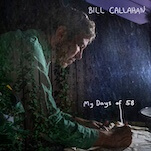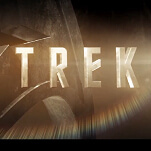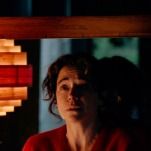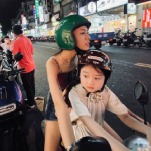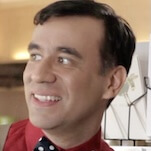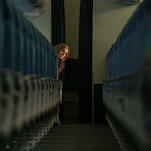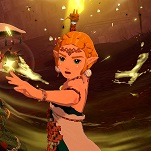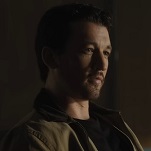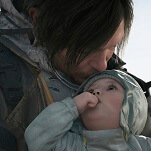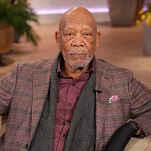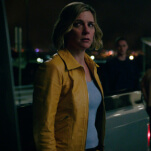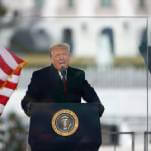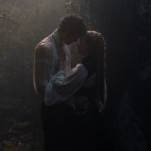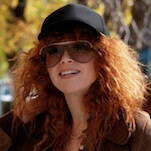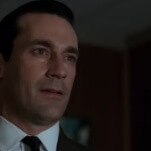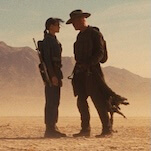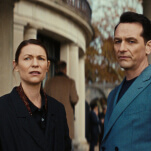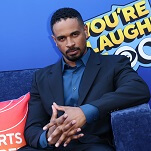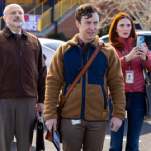There are wytches in the woods, and they’re not happy with how the world perceives their kind. Wytches #1 (Image) begins with a full page dedicated to the dictionary definition of the word “witch” immediately followed by the same full page with one change: the definition has been clawed at and torn. Working in conjunction with the spelling change in the title, these two introductory pages promise an untraditional take on the witch concept, and writer Scott Snyder, artist Jock, and color artist Matt Hollingsworth deliver with a frightening first issue that casts wytches as a primal force of evil deeply ingrained in nature.
This opening chapter doesn’t explicitly define what the wytches are or what they look like, instead focusing on how the supernatural creatures affect the lives of the humans who have the misfortune of crossing their path. In the book’s chilling opening scene, a nameless, noseless mother wakes up trapped in a tree, pledged to the wytches as a sacrificial offering. She begs her child son Timothy to save her as she tries to claw her way out of the small hole in the tree’s trunk, but instead the boy bashes her head in with a rock and delivers an ominous warning: “Pledged is pledged.” That’s when a gray, four-fingered hand reaches out and pulls the mother’s head back into the tree, giving readers their first small look at the horrific creatures at this book’s core.
Witches are typically characterized as human practitioners of the dark arts, but there’s very little that is human about the supernatural beings in this story. The wytches live inside trees and make a “chit” sound, qualities that align them more with insects than humans. When Jock provides the book’s only full-body shot of one of the wytches, the physicality of the creature is insectoid, so much so that a zoomed-out panel makes the deformed woman look like a bug crawling up a tree branch.
This creative team does remarkable work establishing the woods as a place of terror, beginning with a stark four-panel page that shows an ominously quiet forest containing unseen horrors. After two calm panels, an eye appears from behind a hole in a tree’s trunk to bring that horror to the surface, and that evocative visual of an eyeball peeking out from a wooden prison immediately sets an unsettling tone for the rest of the story.
Jock’s staging of the opening sequence creates a pervasive sense of claustrophobia, and Hollingsworth’s speckled coloring makes the setting especially messy and grimy. It’s rare to see the sensation of smell captured so vividly on the page, but there’s a putrid quality to Hollingsworth’s application that evokes the scents of mold and feces and blood to really heighten the nastiness of a wytch attack.
The majority of this first issue focuses on the Rooks family, who have recently relocated following a wytch-related incident involving teen daughter Sailor. While there are some rough patches of clunky exposition—particularly a rushed sequence delving into Charles Rooks’ career as a graphic novelist—Snyder brings a lot of heart to the story through Charles’ tender relationship with his daughter, which serves as a strong contrast to the parent-child dynamic in the book’s opening sequence.
It should come as no surprise that Jock nails the scarier aspects of the story—his strengths lie in creating a moody atmosphere and staging visceral action—but he also does some immensely powerful work with the more intimate, emotional moments. The relationship between Charles and Sailor is quickly established by the characters’ body language in their first scene together, and Jock does incredible work with facial expressions throughout the issue, but especially during moments of heightened fear. This creative team wants readers to feel that fear as intensely as possible, and it will be hard to look at trees the same way after finishing this first issue. [OS]
(Penguin), Anya Ulinich’s debut graphic novel. In the first place, while this is Ulinich’s first stab at comics, it isn’t her first book—that honor goes to 2007’s award-winning
.
is Ulinich’s second book—therefore, somewhere over the course of the preceding seven years, Ulinich made the decision to move from prose to comics. In the second, the synopsis seems more than a little familiar: A woman in her late 30s in recovery from a protracted divorce explores the New York dating scene while also coming to terms with her status as a first-generation immigrant from the Soviet Union.
Let’s unpack these suspicions in order. While it is true that most writers choosing to switch mediums mid-career might warrant more than a suspicious eyeful, Ulinich is well prepared to make this transformation, having earned an MFA at UC Davis before beginning her writing career. Anyone expecting to find an underdeveloped style in these pages will walk away sorely disappointed. Ulinich is a confident and idiosyncratic illustrator with a strong sense of design. The book does get off to a rough start, very much the work of someone with an MFA in studio art stretching her muscles after years away from the drawing board. But this is a big book. By the end of these 360 pages Ulinich has completed the metamorphosis into a genuinely striking and talented cartoonist.
As to the second suspicion: Any fears that the book might live down to its unambitious ad copy are allayed quickly. The obvious comparison, one to which Ulinich is aware, is Elizabeth Gilbert’s paean to self-absorption, Eat, Pray, Love. (After her psychiatrist suggests towards the end of the book that she may very well be able to turn her experiences into a book like Gilbert’s, Ulinich’s reaction is to go fill a prescription for Xanax.)
Lena Finkle isn’t an autobiography. The main character’s name is Lena, not Anya, and despite what appear to be a number of striking similarities between the author’s life and Lena’s, the reader must be satisfied to place a curtain between the fictionalized Lena and the author whose photo on the back of the book looks so very much like Lena.
Whatever similarities the book may have to people real or imagined notwithstanding, the reader closes the book desperately wishing that the people who populate this magnificent book are real, that the never-ending stream of idiotic hipsters in the Brooklyn dating scene are out there shuffling around in the corner of some can-only beer bar; that her childhood love Alik is still skulking around the streets of St. Petersburg like a cut-rate Raskolnikov; and even that the human superfund site known only as the Orphan is out there, somewhere, finally learning a lesson about the way the real world operates. In Lena Finkle, Anya Ulinich has created one of the most appealing fictional alter egos in modern comics. We want her to be real more than anything, for the simple reason that she is such a wonderful person with whom to spend some time.
To say any more would be to give away too much of this delightful and eminently surprising volume. Every opportunity given Ulinich to allow her story to descend into pat sentimentality or noxious moralizing is thankfully averted. The reader is left with a heartbreaking and complex story about people living down to the expectations of those around them, and the ways in which even cartoon characters can surpass mere caricature. [TO]
Like
Lena Finkle’s Magic Barrel, Michael Cho’s
Shoplifter (Pantheon) doesn’t have a particularly exciting or original synopsis: Corinna Park is a young woman with an English literature degree and aspirations of writing a novel, searching for the courage to quit her creatively stifling job penning advertising copy. (She also likes to shoplift magazines from a nearby convenience store, but that’s hardly the focus of the story.) And yet, when realized in Cho’s bold, retro art style, this familiar tale about the internal conflict of the modern artist becomes something beautiful.
Both of these debut graphic novels show how the medium can invigorate a seemingly tired narrative by realizing it through the distinct visual style of a singular creator, and Cho’s crisp, graphic artwork is the major selling point for Shoplifter. The book design by Cho and his wife, Claudia Dávila, gives the title an elegant, sophisticated appearance that makes it stand out on shelves, and the black, white, and pink interior art pops on the page. There’s a cartoonish quality to Cho’s characters that contrasts with the textured grit of his environments, and much of the charm in his artwork comes from that balance of exaggeration and realism.
Shoplifter is reminiscent of Noah Baumbach’s 2013 film Frances Ha in many ways: They both use a monochromatic visual style, and both feature female lead characters living in urban centers where they struggle to pursue creative careers when faced with the reality of adult life. The two pieces do exceptional work capturing a sense of isolation in a crowded city environment, and Cho’s silent splash pages of the city enlarge the scope of the setting to make Corinna appear even smaller and less significant in relation. Corinna shoplifts because it gives her the illusion of control in a world that is stripping her of authority and agency, and that conflict within Corinna is reflected in her relationship with her sprawling surroundings. Getting away with her petty misdemeanors makes Corinna feel powerful, but in order to truly take hold of her future, she needs to find strength outside of shoplifting. [OS]
The test for the New 52 was always going to be just how long it would take for the traditional versions of established characters to reassert themselves. Just as in the years immediately following
Crisis On Infinite Earths, the DC heroes emerged from
Flashpoint changed in ways both superficial and profound. And just as after that previous event, the classical models for each hero began to reassert themselves almost immediately following the establishment of the “All-New, All-Different” status quo.
Superman has been a jerk and sometimes a smug jackass, but over three years after the reboot he seems, finally, to be back to himself. The proof of this can be found in the pages of DC’s recently completed crossover Doomed, spearheaded by the writing team of Greg Pak and Charles Soule. The series did not at first announce itself as anything special—another Doomsday story, this one with the twist of Doomsday having become an airborne virus that can infect Superman and turn him into a deadly Doomsday hybrid. There have been plenty enough underwhelming crossovers in the New 52 that this one on first blush hardly seemed any different.
And then a funny thing happened. Instead of growing more tired with the passing weeks, the story grew more interesting. The initial gimmick of Superman being possessed by Doomsday (becoming, in the process, even more of a jerk than before) soon receded before another, much larger threat. A number of seemingly random threads spread across the multiple Superman titles were suddenly relevant, and every subsequent issue in the story raised the stakes even more. About halfway through the story the villain was revealed to be Brainiac, at which point the real plot became apparent: Brainiac had taken Superman off the board the cleverest way possible, by making Superman a sufficient threat to the world around him that he would exile himself rather than endanger the Earth.
With that, Superman had to reach out to his closest friends and allies to pick up the slack against Brainiac. That’s the moment Doomed transcended the schlocky origins of the New 52 and became something better. Superman’s greatest power has never been his strength or his speed, but his ability to inspire those around him. He trusts his friends and they trust him, and together that trust can be depended on to win the day. Although you could argue the story drags, it’s generous in terms of the fact that every prominent character—from Batman and Wonder Woman to Lex Luthor, Lana Lang, and Lois Lane—gets a moment to shine. And then after seeing his allies fall one by one, only Superman (of course!) is left standing, forced to make the ultimate sacrifice to rid the universe of Brainiac once and for all.
Consciously examining and in turn wholly rejecting the hackneyed distrust and forced conflict that has characterized so much of DC’s recent output, Doomed succeeds in doing the impossible by telling a good old fashioned Superman epic of the kind you just didn’t think they could make anymore. If you squint a little, you might even be able to trick yourself into seeing the little triangle number under the corner box, just like old times. The red shorts are still missed (seriously, the blue bodysuit just doesn’t work without the red shorts and yellow belt to break it up), but after a few years wandering the wilderness, this is, finally, once again, the real deal. [TO]
“This place has an impenetrable history.” From the very first line of
Gotham Academy #1, it’s clear that writers Becky Cloonan and Brenden Fletcher understand the obstacles standing in the way of bringing new readers into the complicated comic-book continuity of Gotham City, and they go out of their way to make this debut issue as accessible as possible to an all-ages audience. Part of the ongoing makeover of the Batman line by editor Mark Doyle,
Gotham Academy #1 is a huge departure from the rest of the Gotham-based titles, a YA high school drama featuring a cast of new characters with no immediate ties to the rest of the DCU (at least at this point). The leads are two teenage girls, the story focuses on adolescent identity crisis and social alienation, and Karl Kerschl’s art has a clean, animated style that gives the entire book a fresh, youthful look.
Kerschl’s slick artwork is a big part of this book’s all-ages appeal, making each panel look like a cel from a meticulously detailed cartoon. The animation influence makes his characters hugely expressive, and Kerschl’s designs reflect individual personalities by showing how different students interpret the standard Gotham Academy uniform. The location is as much a character in this first issue as the rest of the cast, and an early two-page spread provides a quick rundown of the Gotham Academy campus with a cleverly designed panel layout. The amount of detail put into the environment by Kerschl creates a sense of wonder that gives the academy a very Hogwarts vibe, and the rich, atmospheric coloring of Geyser and McCaig bolsters those more spectacular elements.
The writers spend the first half of the issue fleshing out the academy aspect of the book, acclimating readers to the new environment and cast by taking them on a tour with first-year student Maps Mizoguchi and her assigned “nanny” Olive Silverlock, who is currently in the process of breaking up with Maps’ brother Kyle. Once the setting and the characters have all been established, the inevitable weirdness of Gotham makes its way into the story as Maps and Olive investigate rumors of supernatural happenings while Bruce Wayne delivers a keynote speech for the new class of students. Taking the time to establish those personal relationships and lay out the landscape of Gotham Academy makes for an especially immersive first issue, and the writers incorporate just enough Batman to bring the story into that character’s world without having it exist in the Dark Knight’s shadow. [OS]
James Harvey’s
Masterplasty (Image) is the IMAX version of a comic book. Measuring 12 inches wide and 18 inches tall, it’s one of Image’s largest publications ever, and Harvey’s exquisitely rendered artwork at this size is truly breathtaking. As the print edition of assorted webcomics,
Masterplasty gives readers ample justification to shell out $5.99 for stories that can be read online for free, presenting them in an oversized format that makes the digital editions pale in comparison.
Containing the 16-page “Masterplasty,” two three-page short stories, letters, sketches, and assorted other behind-the-scenes materials, this one-shot shows many different sides of an extremely versatile cartoonist. The main story is a captivating piece of urban science fiction, exploring upper-class privilege and the malleability of identity through the experience of an insecure young man whose rich father pays for him to undergo a procedure that alters human physiology in unpredictable ways. Socially conscious with a biting sense of humor, “Masterplasty” is a sharp contrast to the haunting story that follows, a silent tale about a naked overweight man who has a man-eating butterfly on his head; the final piece in this collection takes another drastic tonal shift for a cheeky look at animal breeding on Noah’s arc.
Harvey is able to push himself in so many different directions because he has an outstanding knowledge of artistic fundamentals. A two-page sequence of Tomo’s masterplasty procedure reveals Harvey’s understanding of anatomy, showing X-rays of Tomo’s skeleton as he goes through dramatic changes—some for the better, many for the worse. The huge format makes it easy to get lost in the vivid imagery, and Harvey’s smooth linework and forceful coloring choices make each page a new visual marvel. Masterplasty may not be the easiest comic to transport and display, but for just a few dollars more than a regular-sized 20-page comic, readers can get lost in the wildly imaginative mind of one of the industry’s most promising up-and-coming creators. [OS]



